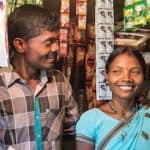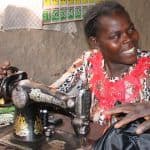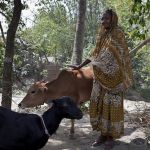From Extremely Poor to Entrepreneur: A Starter Asset Combined with Mentorship Forges Pathway Out of Poverty
If you met Arfa Bibi on the street today, you’d meet a confident entrepreneur – a woman who had worked hard, made smart investments and built a successful farming business. But a few years ago that wasn’t the case. She and her husband struggled to provide for their family, and Bibi had resorted to begging.
How did she pull off this transformation? It started when she began working with Bandhan-Konnagar, a Kolkata-based nonprofit focused on reducing extreme poverty and empowering women. The organization’s Targeting the Hardcore-Poor (THP) program uses a 24-month graduation model to support extremely poor women as they forge a pathway out of poverty through entrepreneurship.
Bandhan-Konnagar works with local communities to identify extremely poor women, using a Participatory Rural Appraisal process to identify the most marginalized women. The process uses rapport building, social mapping and wealth assessments to select participants. These are typically overlooked, extremely poor women in rural areas of India who have not had access to traditional financial initiatives or are unready and reluctant to use such services. These women have no asset base or alternative source of income. They are often highly vulnerable, single mothers or mainly dependent on begging or wage labor.
‘My life changed entirely within 24 months’
Over the course of 10 years, the THP program has reached more than 55,000 beneficiaries in nine states of India through its 360-degree approach that addresses everything from health and lifestyle changes to financial management. The program provides a small, manageable and productive asset or enterprise, like a sewing machine or livestock, that the women can use to generate income. It works closely with these women over the course of two years, taking a hands-on, holistic approach to support and monitor their success. The idea is that at the end of two years, the beneficiary will graduate from the program, and if they wish, go on to mainstream financial opportunities.
Most importantly, the program mentors women as they build the skills they need to leverage what they have into much more. At the same time, it helps women gain knowledge, economic self-reliance and the self-confidence to access the financial services they need to be successful entrepreneurs.
The combination of a productive asset with hands-on mentorship is very powerful. A six-country study by the Massachusetts Institute of Technology (MIT) followed 21,000 of the world’s poorest people for three years, analysing the effectiveness of in fighting extreme poverty.
According to study co-author Abhijit Banerjee, professor of economics at MIT and director of Abdul Latif Jameel Poverty Action Lab (J-PAL), “The ultra-poor face several challenges, beyond just not having sufficient income. They don’t have adequate food or means to save and suffer from low morale to escape from their current situation.”
The research conducted by Banerjee and his team showed that Bandhan-Konnagar’s comprehensive approach “addressed several of these factors at once, and the positive gains in income, livelihoods and health persisted even one year after the programme ended.”
Every rupee spent resulted in 4.33 rupees in benefits for ultra-poor households and participants ended the training program with a 26 percent increase in purchasing power.
Or, as Bibi put it: “My life changed entirely within 24 months.”
From four goats to microfinance loan
Bibi started with just four goats from the Bandhan-Konnagar program, but quickly increased the size of her herd to 11. She sold a few, using the income to purchase chickens, whose eggs she fed to her children and sold in the market. She then sold a few more goats to lease a small parcel of land, where she grew cauliflower. When this proved profitable, Bibi used the money to lease even more land, and now has a strong vegetable-growing business. And she recently took her first microfinance loan to continue to expand.
Few other livelihood models exist quite like the THP program, offering marginalized women like Bibi an opportunity for expansion and economic growth leadership. Most previous efforts to reduce poverty among the ultra-poor have not exhibited a large and long-lasting impact on their standard of living, and very few programs are specifically designed for this segment of the poor. But the THP program’s approach differs from that of traditional microcredit or self-help groups that foster self-employment activities among the poor; with this graduation model, households are not required to repay the asset cost, but instead progress through the program. Further, the training and intensive support from Bandhan-Konnagar helps beneficiaries fully benefit from their chosen self-employment activities. The THP program stands out for its success in addressing multiple challenges of poverty. Simultaneously, this is a model that could make a true difference for the 1.3 billion people living on less than $1.25 a day.
In this video, Damayante Dalei, a graduate of Bandhan-Konnagar’s program, discusses THP’s impact on her life.
As the THP program celebrates its 10th anniversary this year, the cost-effective model is particularly relevant as policymakers, donors and organizations look toward effectively reaching the poorest of the poor. Bandhan-Konnagar believes that as it scales and finds more partners who are willing to adopt its proven model or integrate this approach into their own existing livelihood programs, even more women can grow into successful, self-reliant entrepreneurs and help create strong communities.
Barid Baran is the public relations officer of Bandhan-Konnagar, a Kolkata-based nonprofit, where he is responsible for communication and partnership outreach.
Photo courtesy of Bandhan-Konnagar
- Categories
- Agriculture



